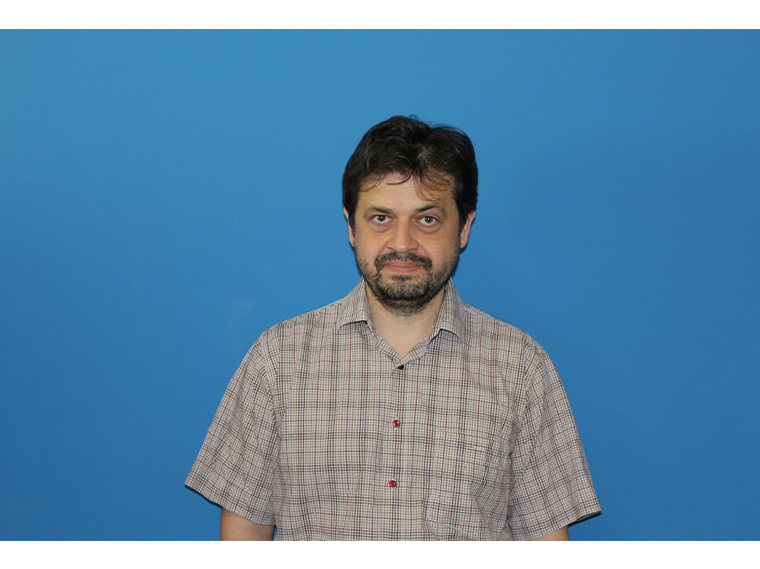
T
+34 946 567 842
F
+34 946 567 842
E
azarnescu@bcamath.org
Information of interest
My research focuses on the analytical study of fundamental models from condensed matter physics. After graduating from the University of Chicago, under the supervision of Prof. Peter Constantin, with a thesis on polymeric fluids, I moved to Oxford, for 5 years, working under the mentorship of Prof. John M. Ball, on variational theories of liquid crystals. After that I moved away from Oxford, and developed my independent directions of research, while at the University of Sussex, as a lecturer, for 5 years. Since 2016 I have been working as an Ikerbasque Research Professor in BCAM, as a research-leader of the Applied Analysis, while also holding an affiliation with the "Simion Stoilow" Institute of Mathematics, in Bucharest, Romania.
-
Boundary layers for the upper-convected Beris–Edwards model of nematic liquid crystals
(2025)In this paper, we derive and analyze a set of Prandtl-type equations for the boundary layers in nematic liquid crystals. We focus on a two-dimensional model where the hydrodynamics are governed by the Beris–Edwards ...
-
On the effect of a large cloud of rigid particles on the motion of an incompressible non–Newtonian fluid
(2024)We show that the collective effect of N rigid bodies (Sn,N)N n of diameters (rn,N)N n immersed in an incompressible non–Newtonian fluid is negligible in the asymptotic limit N → ∞ as long as their total packing volume ...
-
On the collective effect of a large system of heavy particles immersed in a Newtonian fluid
(2024)We consider the motion of a large number of heavy particles in a Newtonian fluid occupying a bounded spatial domain. When we say “heavy”, we mean a particle with a mass density that approaches infinity at an appropriate ...
-
From Monte Carlo to neural networks approximations of boundary value problems
(2024)In this paper we study probabilistic and neural network approximations for solutions to Poisson equation subject to H¨ older data in general bounded domains of Rd. We aim at two fundamental goals. The first, and the most ...
-
GLOBAL EXISTENCE OF WEAK SOLUTIONS FOR A MODEL OF NEMATIC LIQUID CRYSTAL-COLLOIDAL INTERACTIONS
(2024)In this paper we study a mathematical model describing the movement of a colloidal particle in a fixed, bounded three dimensional container filled with a nematic liquid crystal fluid. The motion of the fluid is governed ...
-
Colloidal homogenization for the hydrodynamics of nematic liquid crystals
(2024)This paper analytically explores a simplified model for the hydrodynamics of nematic liquid crystal colloids. We integrate a Stokes equation for the velocity field with a Ginzburg–Landau transported heat flow for the ...
-
Reducing Model Complexity by Means of the Optimal Scaling: Population Balance Model for Latex Particles Morphology Formation.
(2023-04-15)Rational computer-aided design of multiphase polymer materials is vital for rapid progress in many important applications, such as: diagnostic tests, drug delivery, coatings , additives for constructing materials, cosmetics, ...
-
On the motion of a small rigid body in a viscous compressible fluid
(2023)We consider the motion of a small rigid object immersed in a viscous compressible fluid in the 3-dimensional Euclidean space. Assuming the object is a ball of a small radius ε we show that the behavior of the fluid is ...
-
SUFFICIENT CONDITIONS FOR THE EXISTENCE OF MINIMIZING HARMONIC MAPS WITH AXIAL SYMMETRY IN THE SMALL-AVERAGE REGIME
(2023)The paper concerns the analysis of global minimizers of a Dirichlet-type en- ergy functional defined on the space of vector fields H1(S, T ), where S and T are surfaces of revolution. The energy functional we consider ...
-
Interaction energies in paranematic colloids
(2023)We consider a system of colloidal particles embedded in a paranematic—an isotropic phase of a nematogenic medium above the temperature of the nematic-to-isotropic tran- sition. In this state, the nematic order is induced ...
-
On the Motion of a Nearly Incompressible Viscous Fluid Containing a Small Rigid Body
(2023)We consider the motion of a compressible viscous fluid containing a moving rigid body confined to a planar domain ⊂ R2. The main result states that the influence of the body on the fluid is negligible if (i) the diameter ...
-
THE HYDROSTATIC LIMIT OF THE BERIS-EDWARDS SYSTEM IN DIMENSION TWO
(2023)We study the scaled anisotropic co-rotational Beris-Edwards system modeling the hydro- dynamic motion of nematic liquid crystals in dimension two. We prove the global well-posedness with small analytic data in a thin ...
-
Uniform profile near the point defect of Landau-de Gennes model
(2022-11-04)For the Landau-de Gennes functional on 3D domains, $$ I_\varepsilon(Q,\Omega):=\int_{\Omega}\left\{\frac12|\nabla Q|^2+\frac{1}{\varepsilon^2}\left( -\frac{a^2}{2}\mathrm{tr}(Q^2)-\frac{b^2}{3}\mathrm{tr}(Q^3)+\frac{c^ ...
-
Asymptotic behavior of the interface for entire vector minimizers in phase transitions
(2022-09-15)We study globally bounded entire minimizers $u:\mathbb{R}^n\rightarrow\mathbb{R}^m$ of Allen-Cahn systems for potentials $W\geq 0$ with $\{W=0\}=\{a_1,...,a_N\}$ and $W(u)\sim |u-a_i|^\alpha$ near $u=a_i$, $0<\alpha<2$. ...
-
A phenomenological model for interfacial water near hydrophilic polymers
(2022-06-30)We propose a minimalist phenomenological model for the ‘interfacial water’ phenomenon that occurs near hydrophilic polymeric surfaces. We achieve this by combining a Ginzburg–Landau approach with Maxwell’s equations which ...
-
On the motion of a large number of small rigid bodies in a viscous incompressible fluid
(2022)We consider the motion of N rigid bodies – compact sets (S1 ε ,· · · ,SN ε )ε>0 – immersed in a viscous incompressible fluid contained in a domain in the Euclidean space Rd , d = 2,3. We show the fluid flow is not ...
-
Mathematical problems of nematic liquid crystals: between dynamical and stationary problems
(2021-05-24)Mathematical studies of nematic liquid crystals address in general two rather different perspectives: That of fluid mechanics and that of calculus of variations. The former focuses on dynamical problems while the latter ...
-
Entire Minimizers of Allen–Cahn Systems with Sub-Quadratic Potentials
(2021-01-01)We study entire minimizers of the Allen–Cahn systems. The specific feature of our systems are potentials having a finite number of global minima, with sub-quadratic behaviour locally near their minima. The corresponding ...
-
Weak sequential stability for a nonlinear model of nematic electrolytes
(2021-01-01)In this article we study a system of nonlinear PDEs modelling the electrokinetics of a nematic electrolyte material consisting of various ions species contained in a nematic liquid crystal. The evolution is described by a ...
-
Topics in the mathematical design of materials
(2021-01-01)We present a perspective on several current research directions relevant to the mathematical design of new materials. We discuss: (i) design problems for phase-transforming and shape-morphing materials, (ii) epitaxy as an ...
-
Effective surface energies in nematic liquid crystals as homogenised rugosity effects
(2021)We study the effect of boundary rugosity in nematic liquid crystalline systems. We consider a highly general formulation of the problem, able to simultaneously deal with several liquid crystal theories. We use techniques ...
-
ASYMPTOTIC BEHAVIOR OF THE FREE INTERFACE FOR ENTIRE VECTOR MINIMIZERS IN PHASE TRANSITIONS
(2021)We study globally bounded entire minimizers u : Rn → Rm of Allen-Cahn systems for potentials W ≥ 0 with {W = 0}= {a1, ..., aN } and W (u) ∼ |u− ai|α near u = ai, 0 < α < 2. Such solutions are, over large regions, identically ...
-
Symmetry and Multiplicity of Solutions in a Two-Dimensional Landau–de Gennes Model for Liquid Crystals
(2020-05-20)We consider a variational two-dimensional Landau–de Gennes model in the theory of nematic liquid crystals in a disk of radius R. We prove that under a symmetric boundary condition carrying a topological defect of degree ...
-
Design of effective bulk potentials for nematic liquid crystals via colloidal homogenisation
(2020-02-01)We consider a Landau–de Gennes model for a suspension of small colloidal inclusions in a nematic host. We impose suitable anchoring conditions at the boundary of the inclusions, and we work in the dilute regime — i.e. the ...
-
An optimal scaling to computationally tractable dimensionless models: Study of latex particles morphology formation
(2020-02)In modelling of chemical, physical or biological systems it may occur that the coefficients, multiplying various terms in the equation of interest, differ greatly in magnitude, if a particular system of units is used. Such ...
-
Landau-de Gennes Corrections to the Oseen-Frank Theory of Nematic Liquid Crystals
(2020-01-03)We study the asymptotic behavior of the minimisers of the Landau-de Gennes model for nematic liquid crystals in a two-dimensional domain in the regime of small elastic constant. At leading order in the elasticity constant, ...
-
On the uniqueness of minimisers of Ginzburg-Landau functionals
(2020)We provide necessary and sufficient conditions for the uniqueness of minimisers of the Ginzburg-Landau functional for Rn-valued maps under a suitable convexity assumption on the potential and for H1=2 \ L1 boundary data ...
-
On a sharp Poincare-type inequality on the 2-sphere and its application in micromagnetics
(2019-08-21)The main aim of this note is to prove a sharp Poincaré-type inequality for vector-valued functions on $\mathbb{S}^2$ that naturally emerges in the context of micromagnetics of spherical thin films.
-
A Scaling Limit from the Wave Map to the Heat Flow Into S2
(2019-07-08)In this paper we study a limit connecting a scaled wave map with the heat flow into the unit sphere 𝕊2. We show quantitatively how the two equations are connected by means of an initial layer correction. This limit is ...
-
Uniqueness of degree-one Ginzburg–Landau vortex in the unit ball in dimensions N ≥ 7
(2018-09-01)For ε>0, we consider the Ginzburg-Landau functional for RN-valued maps defined in the unit ball BN⊂RN with the vortex boundary data x on ∂BN. In dimensions N≥7, we prove that for every ε>0, there exists a unique global ...
-
Dynamics and flow effects in the Beris-Edwards system modeling nematic liquid crystals
(2018-08-10)We consider the Beris-Edwards system modelling incompressible liquid crystal flows of nematic type. This couples a Navier-Stokes system for the fluid velocity with a parabolic reaction-convection-diffusion equation for the ...
-
Shear flow dynamics in the Beris-Edwards model of nematic liquid crystals
(2018-02-14)We consider the Beris-Edwards model describing nematic liquid crystal dynamics and restrict to a shear flow and spatially homogeneous situation. We analyze the dynamics focusing on the effect of the flow. We show that in ...
-
On a hyperbolic system arising in liquid crystal modelling
(2017-11)We consider a model of liquid crystals, based on a nonlinear hyperbolic system of differential equations, that represents an inviscid version of the model proposed by Qian and Sheng. A new concept of dissipative solution ...
-
Sphere-valued harmonic maps with surface energy and the K13 problem
(2017-11)We consider an energy functional motivated by the celebrated K13 problem in the Oseen-Frank theory of nematic liquid crystals. It is defined for sphere-valued functions and appears as the usual Dirichlet energy with an ...
-
Global well-posedness and twist-wave solutions for the inertial Qian-Sheng model of liquid crystals
(2017-10-02)We consider the inertial Qian-Sheng model of liquid crystals which couples a hyperbolic-type equation involving a second-order material derivative with a forced incompressible Navier-Stokes system. We study the energy law ...
-
Partial regularity and smooth topology-preserving approximations of rough domains
(2017-01-01)For a bounded domain $\Omega\subset\mathbb{R}^m, m\geq 2,$ of class $C^0$, the properties are studied of fields of `good directions', that is the directions with respect to which $\partial\Omega$ can be locally represented ...
-
Liquid crystal defects in the Landau–de Gennes theory in two dimensions — Beyond the one-constant approximation
(2016-12-31)We consider the two-dimensional Landau-de Gennes energy with several elastic constants, subject to general $k$-radially symmetric boundary conditions. We show that for generic elastic constants the critical points consistent ...


